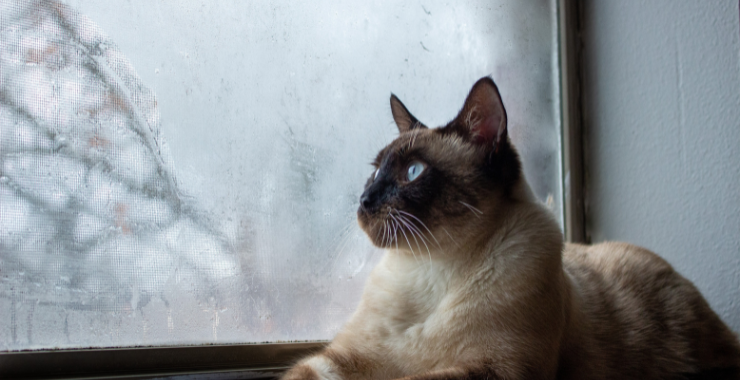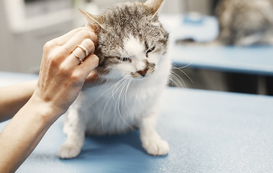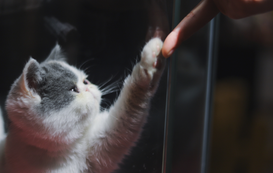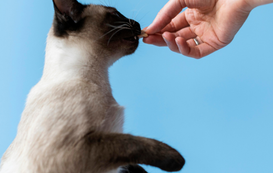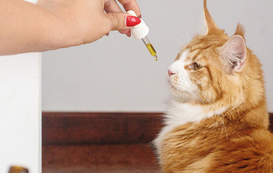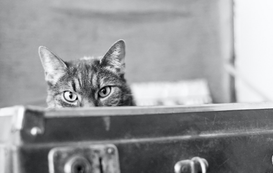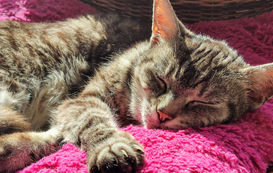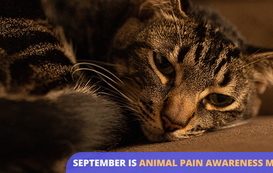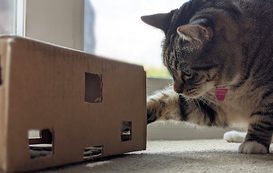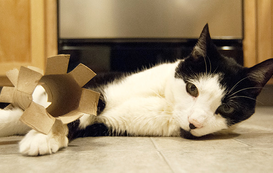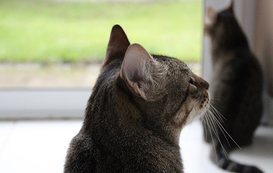Popular posts
The Eye of the Storm: Keep Your Cat Safe When Disaster Strikes
Being a cat parent is one thing, but being a great cat parent means being prepared for any crisis that comes your way. Situations we don't always think about, but unfortunately have become ubiquitous in our world, are natural disasters.
However, when you are responsible for a precious cat's well-being, you cannot deny reality: disaster can and does strike far more often than we'd like to admit. Rather than panicking, we must prepare.
Here's how to keep your cat safe when disaster strikes:
Step One: Figure Out Where You'll Go
First and foremost, you must have a plan for where you and your cat will go if you are required to leave your home. While many people assume they will be able to rely on disaster-aid organizations, it doesn't always work out that way. The American Red Cross states that most of their shelters cannot accept cats "because of health and safety concerns" and other reasons.
If you live in a location prone to hurricanes, floods, or fire, be mindful of the news and weather reports, and write out multiple evacuation routes ahead of time. Find out which hotels and motels along your route will accept cats. If you get some warning and know you may need to evacuate in the coming days, try to make reservations ahead of time. If you are told no about your cat's presence when you attempt to make a reservation, ask if anti-cat policies can be waived in states of emergency.
If you do not find any accommodation in the area, have as many backup options in mind as possible. As part of your preparation plan, make a list of boarding facilities, vets, friends, and relatives willing to take your cat. Be sure to include current phone numbers for everyone on the list and save them on your phone.
Step Two: Use the "One for Each" Rule
You don't need to have cats too long to know they pick up on tension. If you're dealing with an impending disaster, you will be stressed, and your cat may hide, making getting them into a carrier tough.
One thing that can help as part of disaster preparedness is to keep your crates in view during quiet times. Leave the door open - your cat may even wish to use it as a hiding place or sleeping spot rather than relating it to something scary.
Getting panicking cats into any carrier is challenging, much less getting two in one. So, if you have two cats, you need to have one carrier per cat, no matter their size or age. And if you have more, each of your additional kitties needs their own escape pod.
Then, make sure you write your cat's name, your name and phone number, and your vet's name and phone number on each carrier in permanent marker.
Step Three: Ensure Your Cat's Safety
Now is the time to ensure your cat is current on their vaccinations and to consider having them microchipped.
As for more low-tech safety measures, you can easily place an alert sticker on your window or door that tells emergency workers what type/how many cats are in your home or apartment so that they may be rescued if you must leave them behind. The sticker can also include your phone number so your cat's rescuers can reach you. The ASPCA offers an emergency kit that contains one of these stickers.
If you have to face the prospect of leaving your cat behind - as unimaginable as it is - there are things you can do to help ensure their survival.
First, share your evacuation plan and location with friends and relatives so that they know what is happening. Consider leaving a spare key with several of them, and keep in constant communication with them so someone is aware of what is going on and when your cat was left behind. There may be a situation where your friend or family member can go to your home to get your cat out when you cannot. Ensure your loved ones agree about who will complete the rescue mission and where your cat will be taken.
Before leaving your home, place your cat in a small, enclosed area, such as a bathroom, and leave enough kibble and water to sustain them for at least a few days.
Step Four: Have a "Go Bag" and a Backup Plan
As we have previously shared, it is crucial to pack an emergency kit or "go bag" with items such as medications, a feeding dish, food, a blanket, and other must-haves. Sit down, make a list of what you need, and pack the kit immediately. No matter where you end up staying, you will be grateful that you planned ahead of time and were able to bring these necessary items with you.
Making a plan regarding medication is vital, as you may not have the same access to medicines as you might have to food and water. Always try to refill prescriptions before you get to the last few doses so that you'll have some extra doses on hand.
Even if the storm does not directly impact you, it is not unusual for the power to go out in other areas during a hurricane. If you feed your cat prepared food that requires refrigeration or cook whole foods for your cat, you need to think about what you will do if the power goes out. Don't assume you can use what's on hand just because it's in the fridge. According to the CDC, food in the refrigerator is only good for a surprisingly short four hours once the power goes out, and that's only if the door remains closed at all times.
You'll also need to consider water in case it is impacted. Consider this: when preparing an emergency kit, the CDC recommends we store at least one gallon of water per person per day and try to store a two-week supply if possible. According to Preventive Vet's Dr. Beth Turner, cats need about a half cup of water per five pounds daily. This is one situation where having more than you think you need is always better than having too little. The CDC advises us to be mindful of bottled water's expiration date and suggests replacing it every six months.
Step Five: Prepare for the Worst
What if you lose your cat?
First, don't panic. Instead, take action.
It's a great idea to have a "Lost Cat" flyer already made up ahead of time to keep in your emergency kit. If you don't want to do this, at least have pictures ready on your phone and start composing an accurate description of your kitty that you could use if the time comes. No one wants to see their kitty on a flyer if it hasn't happened, but consider how glad you'll be to have it should the worst happen.
Next, call your local animal shelter and your vet's office. Visit all local and national organizations' websites created to rescue lost cats and reunite them with their parents following the disaster. Speak with neighbors, mail carriers, landlords, construction workers - anyone in the area who might've seen your cat. (However, you must not enter the area until you have been given the all-clear to do so by disaster officials.) Word of mouth can do wonders in this situation.
Reach out to other local vets and send them a copy of your flyer so they can share it. Ensure your animal control office and humane society also receive it. Additionally, a quick google for lost cat databases will yield several websites where you can post your flyer for free.
The most important thing is not to give up - a surprising number of cats are reunited with their parents weeks or even months after they go missing.
The Takeaway
Having a disaster preparation plan in place is crucial to being the best cat parents we can be. Knowing ahead of time where you can go and what you need to take with you will give you great peace of mind.
And speaking of peace of mind, Meowtel sitters are the total ex-purr-ts at providing cat parents just that. You can count on our cat sitters to give excellent care to your furbaby - rain or shine!
If you're a Meowtel sitter, consider asking cat parents to provide details regarding their disaster preparation plan before their reservation starts. (This could be a great discussion point for your Meet & Greet!)
Search for your sitter match here, and don't forget to share your disaster contingency plan with your sitter so that everyone will stay safe and sound.
Photo by Hana Oliver on Unsplash

